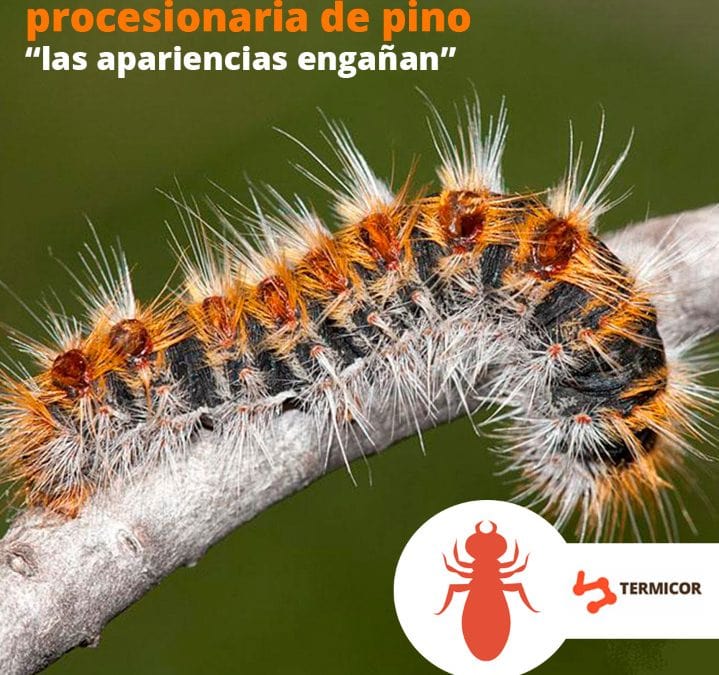If Woody Allen will allow me, I will freely copy the title of one of his films to try to tell you everything you need to know about the processionary and never dared to ask.

Technically, the pine processionary (Thaumetopoea pityocampa) is an insect pest that mainly affects pines and cedars. It is characterized by hairy larvae that form processions in search of food and nesting sites. These larvae are known for their stinging ability, as they release microscopic hairs that can cause skin and respiratory irritation in humans and animals. Very interesting, but the truth is that it is a type of caterpillar. Yes, it can be somewhat dangerous if we touch it or if, unfortunately, it detaches from a branch and falls in our eyes.
As it mainly affects pine trees, you have surely already imagined that Mallorca is a place where the processionary is common in our forests.
The good side of the processionary
Among everything you need to know about the processionary and never dared to ask, you should know that not everything is bad in this little oruguita.
In its life cycle, the pine processionary may play certain ecological roles that could be considered beneficial in certain circumstances. Some of these potential benefits include:
- Predator feeding: Processionary larvae are a food source for various predators, such as birds, insects, and some species of bats. These predators benefit from the abundance of processionary larvae as a food source during certain times of the year.

- Nutrient recycling: When larvae feed on trees, they process plant matter and excrete waste, which can contribute to nutrient recirculation in the forest ecosystem.
- Regulation of populations: The presence of the pine processionary in an area can influence the dynamics of plant and animal populations, helping to maintain ecological balance by regulating the abundance of certain plant and animal species.
However, these potential benefits must be balanced against the considerable damage that the pine processionary can cause to pine and cedar forests, as well as to public health. Its stinging hairs can cause severe irritation in humans and animals, and defoliation of trees can weaken them and lead to the loss of biodiversity in forest ecosystems.
In general, although there are ecological aspects in which the pine processionary can play a role, its predominant classification is that of a harmful forest pest. Proper control of their population is important to minimize negative impacts on ecosystems and public health.
The dark side of the caterpillar
In everything you need to know about the processionary and never dared to ask there are negative aspects. The pine processionary can cause a number of significant damages to pine and cedar forests, as well as to the health of people and animals. Some of the main damages caused by the processionary are:
- Damage to trees: Processionary larvae feed on the leaves of pines and cedars, which can lead to massive defoliation of trees. Leaf loss weakens trees and can make them more susceptible to other diseases and pests.
- Impact on biodiversity: Defoliation caused by the processionary can negatively affect biodiversity in forests. Reduced vegetation can affect other plant and animal species that depend on pines and cedars for their habitat and food.

- Public health concerns: The stinging hairs of processionary larvae can cause skin and respiratory irritation in humans and animals. This irritation can be severe in some people and may require medical treatment. In addition, inhaling stinging hairs can lead to respiratory problems.
- Problems for wildlife: The processionary can be a source of food for some predators, but it can also be harmful to fauna that is not adapted to feed on them. For example, stinging hairs can cause damage to the mouth and throat of some animals.
- Economic impact: The presence of processionary in forest areas can have a negative economic impact on the timber industry and forest management.
- Pet Risk: Pets, such as dogs and cats, are often curious and can come into contact with processionary larvae. This can lead to them developing health problems due to irritation caused by stinging hairs.
Given the ability of the pine processionary to cause damage to trees, biodiversity, public health, and the economy, it is important to take appropriate control and management measures to limit its spread and minimize its negative effects on ecosystems and society.
What can we do?
Of course? Of everything you need to know about the processionary and never dared to ask, the most important part is what we can do to be able to live with this species in a way that is safe for both of us. To eradicate the pine processionary and control its spread, pest control companies can carry out various actions, which may include:
- Chemical treatments: Specific chemicals are used for the control of the pine processionary. These products are applied in a careful and controlled manner in places where the presence of larvae or nests has been detected. It is important that these treatments are carried out by trained professionals to minimize environmental impact and exposure to people and animals.
- Traps: Specific traps for the pine processionary can be used to capture adult butterflies before they lay eggs, thus reducing the larval population.
- Pruning: In some cases, selective pruning can be performed on affected trees to remove nests and larvae. This should be done with caution to avoid the spread of stinging hairs.
- Prevention: Prevention is key to controlling the pine processionary. This involves regularly monitoring trees for early signs of infestation and taking appropriate control measures before the pest spreads.
It is important to note that the control of the pine processionary is a complex task and must be carried out by professionals with experience in pest management. In addition, environmental and safety regulations must be followed to protect both the natural environment and the health of people and animals.


